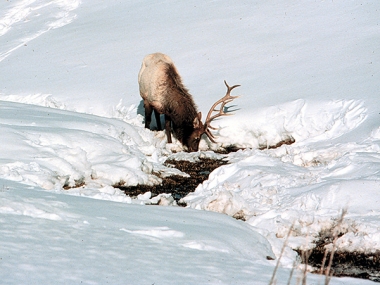
Central Area
Table of Contents
Recreation Report

CENTRAL BIG GAME HUNTING
December 18, 2025
Fall bear, cougar (Check current harvest numbers), coyote, 200 series elk. (Check regulations for specific dates and units)
Announcements, resources
2025 Big Game Hunting Forecast
Big game harvest statistics - You'll find links to population, harvest and point summary reports that can help you decide what hunts to apply for next season.
Please report elk with hoof disease - If you see elk showing signs of elk hoof disease, including lame or limping elk or elk with damaged, injured, missing or deformed hooves, please report it using this online form.
Coyote and wolf ID - Coyote hunters need to take extra care to identify their target as wolves can look like coyotes, especially wolf pups in the mid-summer and fall. Test your ID skills. Please report any wolf sightings or wolf sign to ODFW using the online reporting system.
District updates
PRINEVILLE/OCHOCO WILDLIFE DISTRICT (Maury, Ochoco, Grizzly)
Deer: Temperatures in the region are finally starting to cool down. This should encourage more daytime movement for wildlife. Fire scar areas should be a productive place to start looking for deer. Take some time to get out and walk on closed roads, looking for tracks.
Black bear: Season continues through December 31. Look for bear signs throughout the forest, particularly in areas with berry patches and down/dead/burnt logs.
Cougar: Present throughout the Maury, Ochoco, and Grizzly units. The Maury and Ochoco units are recommended because of their greater amounts of public land and better accessibility.
Coyotes: Offer an exciting hunting challenge. Both Maury and Ochoco have sizeable areas of public lands that provide hunting opportunities. Hunters should use caution and be properly equipped and prepared for whatever the weather might bring.
Travel Management: Just a reminder that the Ochoco District has several cooperative Travel Management Areas that limit motor vehicle use on certain roads. These maps can be downloaded for free on Avenza.
Map of South Boundary (year-round)
DESCHUTES DISTRICT (Upper Deschutes, Paulina, North Wagontire, Northwest Fort Rock, Metolius)
WINTER RANGE CLOSURES ARE IN EFFECT: Three winter range closures are in effect through March 31st across the district. The Metolius, Tumalo, and Cabin Lake-Silver Lake closures are designed to limit the disturbance to the wintering deer and elk in their core winter ranges. Motorized travel is prohibited except on green-dot roads, but non-motorized travel is permitted. Keep this in mind if you have a late season elk tag, are looking to do some predator hunting, or shed hunting later in the spring.
Elk: There are a few late season antlerless controlled elk hunts in the district.
- North Lake (277A): This season runs from Oct 1 – Mar 31. This hunt is designed to target wintering elk that cause agricultural damage to pivots in Fort Rock and Christmas Valley. Waiting until later in the season when more elk are on the winter range and there is snow to track is recommended. Places to look include Coyote Butte and around Oatman Flat. Know that beginning December 1, the Cabin Lake-Silver Lake Winter Range Closure begins. This will limit motorized traffic in the area to limit impacts to wintering deer and elk.
- Tumalo (234B): The Tumalo cow season opens Nov 20 and runs until Dec 31. This season is also designed to address agricultural damage around pivots. Elk are present in the area, but primarily on private land. Remember you must get permission from landowners prior to hunting if you are hunting on private land.
Youth Cow Seasons (234T & 235T): Youth cow seasons run until Dec 31. Areas around Wickiup Reservoir and Crane Prairie can be good while accessible (and with the lack of snowfall this year, they should remain so for a while) for 234T. Hole-in-the-Ground and Spring Butte TMA can be good places for those with 235T. Know that beginning December 1, the Cabin Lake-Silver Lake Winter Range Closure begins. This will limit motorized traffic in the area to limit impacts to wintering deer and elk.
Black bear: Fall season continues through Dec. 31. Areas with lots of downed timber can provide good places for bears to search for grubs. Predator calling can be effective, just be patient and know your target. As the weather gets colder, bears will be more focused on packing on as many pounds as possible before the looming hibernation. This will have them on the move and wandering as they look for good food sources.
Cougar: Found throughout the Deschutes District. Look for cougars wherever there are prey species. Locating a fresh kill and sitting on it can be the most effective method for locating a cougar. Predator calls are another effective method of locating a cougar.
Coyote: Good numbers of coyotes can be found throughout the Deschutes District. Calling coyotes with distress type calls has been effective for hunters. Calling in the early morning and late afternoon produces the best results. It is important to choose areas with abundant coyote signs and little human activity.
